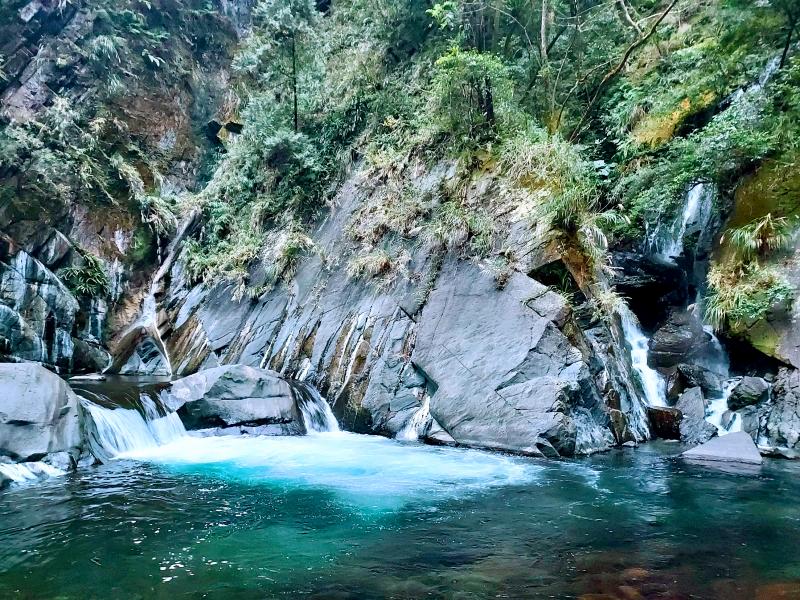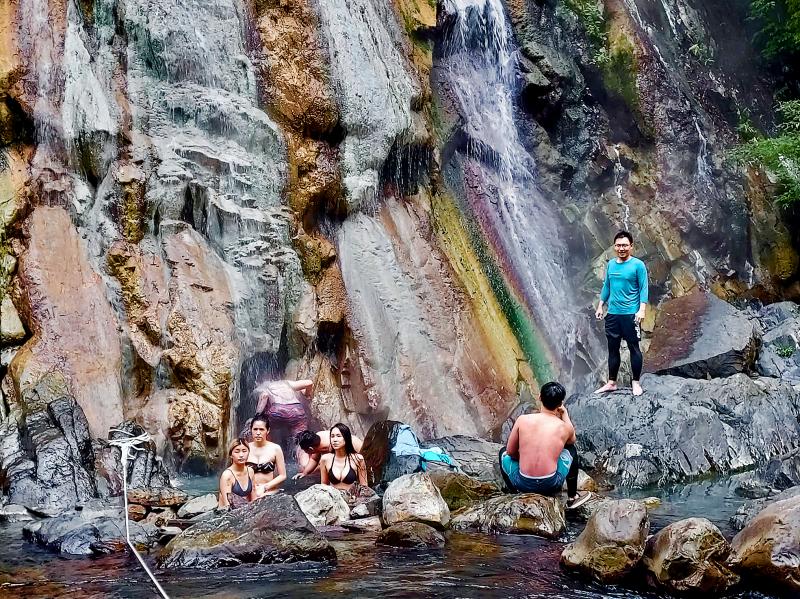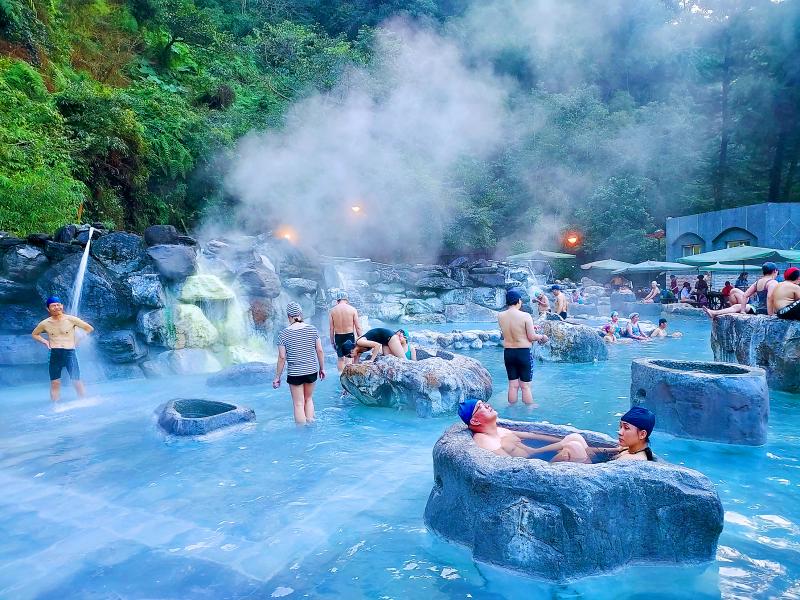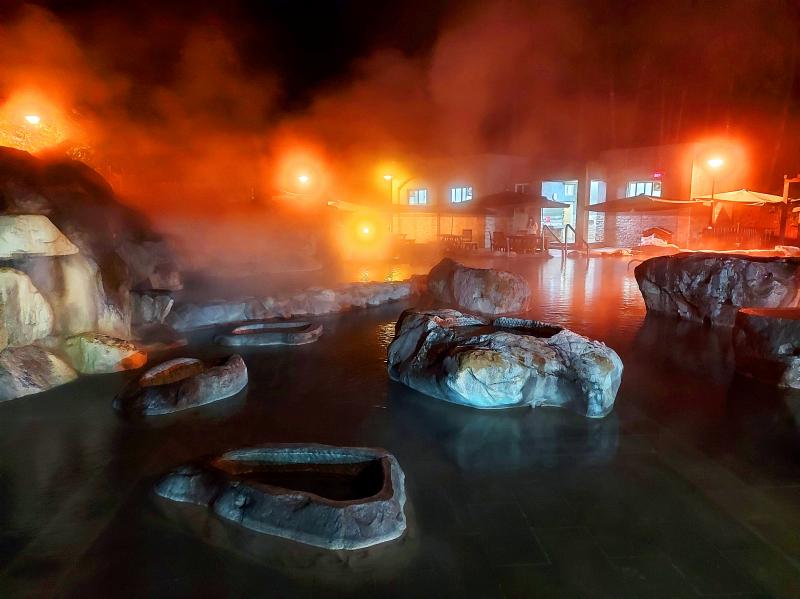Though there are no actively erupting volcanoes on Taiwan, evidence of the geothermal activity lurking just below the surface abounds. This takes the form of natural hot springs, with some developed into commercial attractions, but even more still wild, quietly awaiting those who are prepared to make the journey on foot. Further evidence comes in the form of a geyser, erupting regularly with geothermally heated water. All of these can be enjoyed as part of a cross-island journey from Taoyuan to Yilan on the Northern Cross-Island Highway (北橫公路).
The Northern Cross-Island Highway was completed in the 1960s, partially following a former police trail from the Japanese era. Though it is the lowest of the three major cross-island highways, it does not lack in stunning scenery. It is also the only one of the three that is open in its entirety at the moment, and given its proximity to the capital, makes for a great day trip from anywhere in northern Taiwan. An even better itinerary is to take two or three days and visit some of the geothermal wonders along the way.
SILENG WILD HOT SPRINGS

Photo: Tyler Cottenie
Just east of Sileng (四稜) — the site of a former police station where a smattering of buildings still remain — next to the 58.5K marker, is the trailhead for Sileng Hot Springs. There is a red sign here discouraging entry due to the “wet and slippery” trail, along with another smaller sign from the National Fire Agency encouraging hikers to download their 119 app for reporting emergencies. This alone is evidence of the great change in official attitudes toward outdoor recreation in recent years: previously, the attitude was not to discourage but to outright forbid.
The trail descends for half an hour through broadleaf forest, passing two flat areas that are often used as campsites; the latter can comfortably hold 20 to 30 people. Beyond the second campsite, the trail becomes much steeper. Scrambling over roots and rocky ledges is required, but there are ropes in place for assistance. Finally, just before reaching the riverbed, the hot springs area comes into view: a colorful cascade of hot water coursing down the cliff on the opposite bank into a collection of pools at the bottom.
Reaching the riverbed itself presents the penultimate technical challenge of the hike. There is a choice between a vertical mid-air descent by rope, or a vertical descent on a shaky homemade rope ladder. You did install that 119 app, right?

Photo: Tyler Cottenie
The riverbed area opposite the springs is wide, flat and rocky. Day hikers use this area for picnicking, while others choose to spend the night here, though the rocky ground would not make for comfortable tenting. The final hurdle to overcome is the river crossing, as the soaking pools are on the opposite side of the river. Fortunately, there are two ropes in place to hold onto as one crosses the river. Unfortunately, these ropes are fairly loose and the current is quite strong, so extreme care is still required to get across without falling and injuring one’s legs or feet on the rocks. Before crossing, the slope above the springs should be examined for any loose rocks that may be about to fall.
After crossing the river, one has a choice of about three different interconnected pools in which to soak. The pools have been designed so as to allow just enough river water in to maintain a comfortable temperature, approximately 39 degrees, without any obvious hot or cold spots. It is one of the best designed wild soaking areas this author has encountered in the whole country. As if that weren’t enough, there is also a small cave behind a curtain of falling hot water, just big enough for one person to enter and enjoy a natural steam room experience.
AN ATTRACTIVE DEVELOPED SPRING

Photo: Tyler Cottenie
After the Northern Cross-Island Highway descends to the bottom of the Lanyang River valley in Yilan County, it veers north-east toward Yilan City. A short drive in the other direction along Provincial Route 7 takes one to the entrance to the Taipingshan National Forest Recreation Area (太平山森林遊樂區), where two more geothermal attractions await: a developed hot spring site, and Taiwan’s only geyser.
First developed by the Japanese for the loggers working in the area, the Jioujhihze (鳩之澤) hot spring is a must-visit for anyone coming to the Taipingshan area. The current outdoor soaking pool’s atmosphere is hard to beat among Taiwan’s developed hot springs. The pool is artfully designed using natural stone, and the water glows an attractive blue color reminiscent of the Blue Lagoon in Iceland. There is a hot spring waterfall feature, and several raised stone tubs for individual soaking. The facility also offers a nude hot spring area and private soaking rooms.
Adjacent to the hot springs is an area where visitors can cook eggs or corn in hot spring water. Again, what sets this apart from similar facilities elsewhere in Taiwan is its attractive design. Bubbles introduced into the two stone cooking pools transform them into massive steaming geothermal cauldrons, enveloping visitors in clouds of fog, while the cooling pools for cooked eggs feature fun frog sculptures.

Photo: Tyler Cottenie
TAIWAN’S OLD FAITHFUL
Just east of here in the Tiangou River (天狗) valley is more evidence of the geothermal activity: the Tiangou Geyser. It can be accessed off of the main Taipingshan road, via a two-kilometer walk down a service road, or by tracing two kilometers upriver from the bridge on Provincial Route 7. The former starts at an unmarked intersection half a kilometer farther uphill from the turnoff to Jioujhihze, while the latter should only be attempted when the river level is low, as several crossings are necessary.
Visitors won’t have to wait long for the show, as the geyser erupts every 15 to 20 minutes, reaching heights of 10 meters. Close inspection between eruptions reveals a pipe in the ground here. In fact, the geyser is the result of past drilling by the Industrial Technology Research Institute, in an attempt to develop an economically viable geothermal energy source. The project was unsuccessful but the drilled well remains.
Further exploration along the Northern Cross-Island Highway and its branch roads will turn up even more wild hot springs, enough for more than a full season of weekend soaking. Fittingly, the final evidence of Taiwan’s geothermal underbelly is a dormant volcano, Turtle Island (龜山島), which comes into view off the coast of Yilan just as one reaches the end of the highway.

This month the government ordered a one-year block of Xiaohongshu (小紅書) or Rednote, a Chinese social media platform with more than 3 million users in Taiwan. The government pointed to widespread fraud activity on the platform, along with cybersecurity failures. Officials said that they had reached out to the company and asked it to change. However, they received no response. The pro-China parties, the Chinese Nationalist Party (KMT) and Taiwan People’s Party (TPP), immediately swung into action, denouncing the ban as an attack on free speech. This “free speech” claim was then echoed by the People’s Republic of China (PRC),

Exceptions to the rule are sometimes revealing. For a brief few years, there was an emerging ideological split between the Democratic Progressive Party (DPP) and Chinese Nationalist Party (KMT) that appeared to be pushing the DPP in a direction that would be considered more liberal, and the KMT more conservative. In the previous column, “The KMT-DPP’s bureaucrat-led developmental state” (Dec. 11, page 12), we examined how Taiwan’s democratic system developed, and how both the two main parties largely accepted a similar consensus on how Taiwan should be run domestically and did not split along the left-right lines more familiar in

Many people in Taiwan first learned about universal basic income (UBI) — the idea that the government should provide regular, no-strings-attached payments to each citizen — in 2019. While seeking the Democratic nomination for the 2020 US presidential election, Andrew Yang, a politician of Taiwanese descent, said that, if elected, he’d institute a UBI of US$1,000 per month to “get the economic boot off of people’s throats, allowing them to lift their heads up, breathe, and get excited for the future.” His campaign petered out, but the concept of UBI hasn’t gone away. Throughout the industrialized world, there are fears that

Most heroes are remembered for the battles they fought. Taiwan’s Black Bat Squadron is remembered for flying into Chinese airspace 838 times between 1953 and 1967, and for the 148 men whose sacrifice bought the intelligence that kept Taiwan secure. Two-thirds of the squadron died carrying out missions most people wouldn’t learn about for another 40 years. The squadron lost 15 aircraft and 148 crew members over those 14 years, making it the deadliest unit in Taiwan’s military history by casualty rate. They flew at night, often at low altitudes, straight into some of the most heavily defended airspace in Asia.